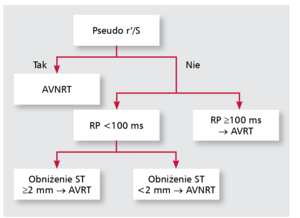Piśmiennictwo
1. Trohman RG. Supraventricular tachycardia: implications for the intensivist. Crit Care Med 2000; 28: N129.
2. Blomström-Lundqvist C, Scheinman MM, Aliot EM, et al. ACC/AHA/ESC guidelines for the management of patients with supraventricular arrhythmias - executive summary: a report of the American College of Cardiology/American Heart Association Task Force on Practice Guidelines and the European Society of Cardiology Committee for Practice Guidelines (Writing Committee to Develop Guidelines for the Management of Patients With Supraventricular Arrhythmias). Circulation 2003; 108: 1871.
3. Zalecenia dotyczące stosowania rozpoznań elektrokardiograficznych. Dokument opracowany przez Grupę Roboczą powołaną przez Zarząd Sekcji Elektrokardiologii Nieinwazyjnej i Telemedycyny Polskiego Towarzystwa Kardiologicznego. Pod patronatem Polskiego Towarzystwa Kardiologicznego. Kardiologia Polska 2010: t. 68 (supl. IV).
4. Buxton AE, Calkins H, Callans DJ, et al. ACC/AHA/HRS 2006 key data elements and definitions for electrophysiological studies and procedures: a report of the American College of Cardiology/American Heart Association Task Force on Clinical Data Standards (ACC/AHA/HRS Writing Committee to Develop Data Standards on Electrophysiology). J Am Coll Cardiol 2006; 48(11): 2360-2396.
5. Saoudi N, Cosio F, Waldo A, et al. Classification of atrial flutter and regular atrial tachycardia according to electrophysiologic mechanism and anatomic bases: a statement from a joint expert group from the Working Group of Arrhythmias of the European Society of Cardiology and the North American Society of Pacing and Electrophysiology. J Cardiovasc Electrophysiol 2001; 12(7): 852-866.
6. Gillette PC, Garson A. Electrophysiologic and pharmacologic characteristics of automatic ectopic atrial tachycardia. Circulation 1977; 56: 571-575.
7. Bashir Y, Betts TR, Rajappan K. Atrial tachycardia and AF. [W:] Cardiac Electrophysiology and Catheter Ablation. Oxford University Press, Oxford 2010.
8. Tang CW, Scheinman MM, Van Hare GF, et al. Use of P wave configuration during atrial tachycardia to predict site of origin. J Am Coll Cardiol 1995; 26(5): 1315-1324.
9. Jaeggi ET, Gilljam T, Bauersfeld U, et al. Electrocardiographic differentiation of typical atrioventricular node reentrant tachycardia from atrioventricular reciprocating tachycardia mediated by concealed accessory pathway in children. Am J Cardiol 2003; 91: 1084-1089.
10. Kalbfleisch SJ, el-Atassi R, Calkins H, et al. Differentiation of paroxysmal narrow QRS complex tachycardias the using 12-lead electrocardiogram. J Am Col Cardiol 1993; 21: 85-89.
11. Cosío FG, Martín-Peñato A, Pastor A, et al. Atypical flutter: a review. Pacing Clin Electrophysiol 2003; 26(11): 2157-2169.
12. Akhtar M, Jazayeri MR, Sra J, et al. Atrioventricular nodal reentry. Clinical, electrophysiological, and therapeutic considerations. Circulation 1993; 88(1): 282-95.
13. Ganz LI, Friedman PL. Supraventricular tachycardia. N Engl J Med 1995; 332(3): 162-173.
14. Arruda MS, McClelland JH, Wang X, et al. Development and validation of an ECG algorithm for identifying accessory pathway ablation site in Wolff-Parkinson-White syndrome. J Cardiovasc Electrophysiol 1998; 9: 2-12.
15. Fitzpatrick AP, Gonzales RP, Lesh MD, et al. New algorithm for the localization of accessory atrioventricular connections using a baseline electrocardiogram. J Am Coll Cardiol 1994; 23: 107-16.
16. Kusumoto F. Supraventricular tachycardia. [W:] ECG Interpretation: From Pathophysiology to Clinical Application, Springer Science+Business Media, LLC 2009.
17. Riva SI, Della Bella P, Fassini G, et al. Value of analysis of ST segment changes during tachycardia in determining type of narrow QRS complex tachycardia. J Am Coll Cardiol 1996; 27(6): 1480-1485.
18. Erdinler I, Okmen E, Oguz E, et al. Differentiation of narrow QRS complex tachycardia types using the 12-lead electrocardiogram. Ann Noninvasive Electrocardiol 2002; 7(2): 120-126.
19. Arya A, Kottkamp H, Piorkowski C, et al. Differentiating atrioventricular nodal reentrant tachycardia from tachycardia via concealed accessory pathway. Am J Cardiol 2005; 95(7): 875-878.
